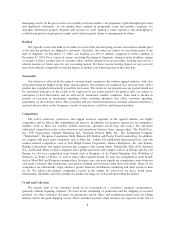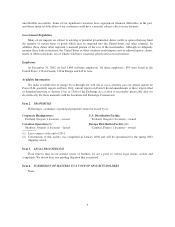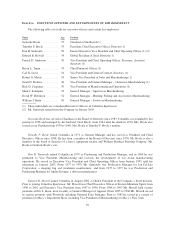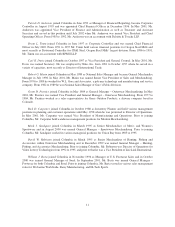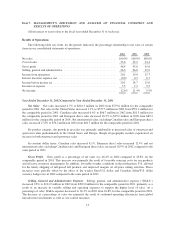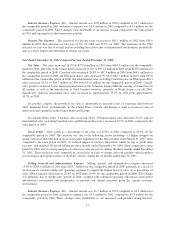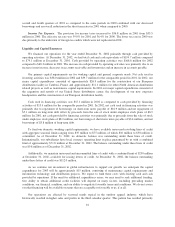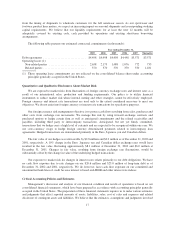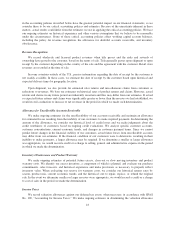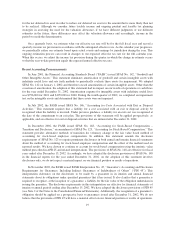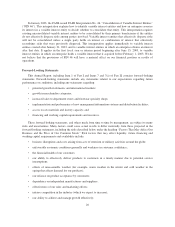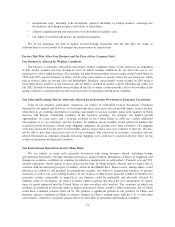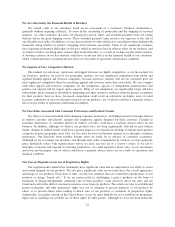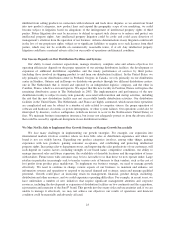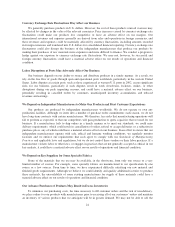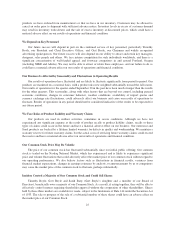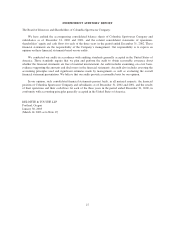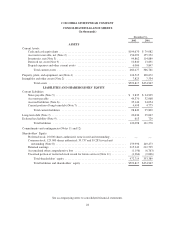Columbia Sportswear 2002 Annual Report Download - page 25
Download and view the complete annual report
Please find page 25 of the 2002 Columbia Sportswear annual report below. You can navigate through the pages in the report by either clicking on the pages listed below, or by using the keyword search tool below to find specific information within the annual report.in the accounting policies described below have the greatest potential impact on our financial statements, so we
consider these to be our critical accounting policies and estimates. Because of the uncertainty inherent in these
matters, actual results could differ from the estimates we use in applying the critical accounting policies. We base
our ongoing estimates on historical experience and other various assumptions that we believe to be reasonable
under the circumstances. Some of these critical accounting policies affect working capital account balances,
including the policy for revenue recognition, the allowance for doubtful accounts receivable, and inventory
obsolescence.
Revenue Recognition
We record wholesale and licensed product revenues when title passes and the risks and rewards of
ownership have passed to the customer, based on the terms of sale. Title generally passes upon shipment or upon
receipt by the customer depending on the country of the sale and the agreement with the customer. Retail store
revenues are recorded at the time of sale.
In some countries outside of the U.S., precise information regarding the date of receipt by the customer is
not readily available. In these cases, we estimate the date of receipt by the customer based upon historical and
expected delivery times by geographic location.
Upon shipment, we also provide for estimated sales returns and miscellaneous claims from customers as
reductions to revenues. We base our estimates on historical rates of product returns and claims. However, actual
returns and claims in any future period are inherently uncertain and thus may differ from our estimates. If actual
or expected future returns and claims were significantly greater or lower than the reserves we had established, we
would record a reduction or increase to net revenues in the period in which we made such determination.
Allowance for Uncollectible Accounts Receivable
We make ongoing estimates for the uncollectibility of our accounts receivable and maintain an allowance
for estimated losses resulting from the inability of our customers to make required payments. In determining the
amount of the allowance, we consider our historical level of credit losses and we make judgments about the
credit worthiness of customers based on ongoing credit evaluations. We analyze specific customer accounts,
customer concentrations, current economic trends, and changes in customer payment terms. Since we cannot
predict future changes in the financial stability of our customers, actual future losses from uncollectible accounts
may differ from our estimates. If the financial condition of our customers were to deteriorate, resulting in their
inability to make payments, a larger allowance may be required. If we determine a smaller or larger allowance
was appropriate, we would record a credit or a charge to selling, general and administrative expense in the period
in which we made the determination.
Inventory Obsolescence and Product Warranty
We make ongoing estimates of potential future excess, close-out or slow moving inventory and product
warranty costs. We identify our excess inventory, a component of which is planned, and evaluate our purchase
commitments, sales forecasts, and historical experience and make provisions as necessary to properly reflect
inventory value. When evaluating our reserve for warranty costs, we consider our historical returns rates by
season, product mix, current economic trends, and the historical cost to repair, replace, or refund the original
sale. In the event we determine smaller or larger reserves were appropriate, we would record a credit or a charge
to cost of sales in the period we made the determination.
Income Taxes
We record valuation allowances against our deferred tax assets, when necessary, in accordance with SFAS
No. 109, “Accounting for Income Taxes.” We make ongoing estimates in determining the valuation allowance
18


